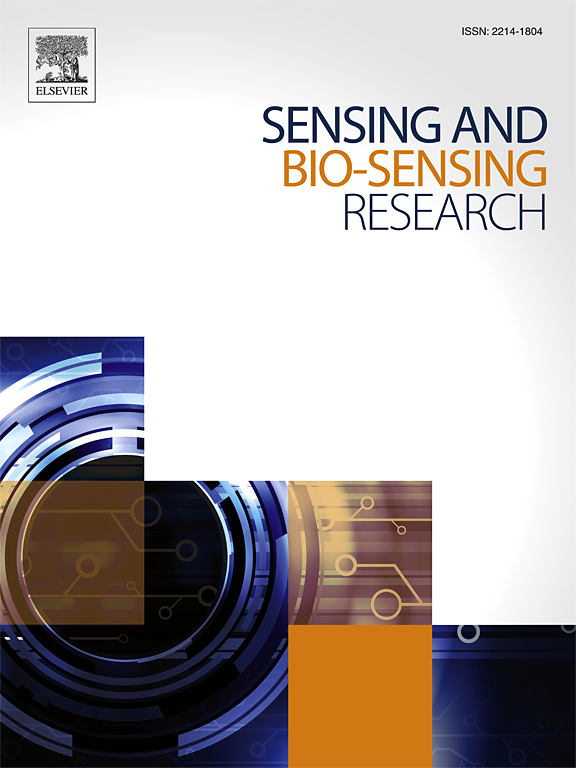CRISPR-integrated metal-organic frameworks for biosensing applications: Recent advances and future perspective
IF 5.4
Q1 CHEMISTRY, ANALYTICAL
引用次数: 0
Abstract
Metal-organic frameworks (MOFs) are porous substances characterized by elevated surface areas and adjustable pore dimensions used in diverse applications, including gas storage, catalysis, drug delivery, and sensing. Biosensing is a promising field that aims to identify and quantify biomolecules such as DNA, RNA, and proteins with high sensitivity and specificity. Biosensors use a transducer and a biological recognition element to make an output correlated with the level of the target analyte. They have advantages over conventional methods, such as simplicity, rapidity, portability, and low cost. Recently, a new type of biosensor has emerged that integrates MOFs with CRISPR, a powerful gene editing tool. Biosensing can utilize CRISPR-Cas systems, as the cleavage of target DNA or RNA by Cas proteins generates detectable signals. MOFs can be used to hold, protect, and release CRISPR-Cas parts; improve signal transduction and amplification; and provide a wide range of functions and tunability for CRISPR-based biosensors by incorporating various metal nodes, organic linkers, pore sizes, and surface modifications. This review discusses recent advancements and challenges in MOF-CRISPR biosensor development, focusing on design principles, sensing mechanisms, and performance. It explores potential applications in biomedical and environmental fields like disease diagnosis, gene therapy, and pollutant monitoring and offers future directions for improvement.
crispr集成金属有机框架的生物传感应用:最新进展和未来展望
金属有机框架(mof)是一种多孔物质,其特点是表面积高,孔径可调,可用于多种应用,包括气体储存、催化、药物输送和传感。生物传感是一个很有前途的领域,旨在以高灵敏度和特异性识别和量化生物分子,如DNA、RNA和蛋白质。生物传感器使用传感器和生物识别元件使输出与目标分析物的水平相关。与传统方法相比,它们具有简单、快速、可移植性和低成本等优点。最近出现了一种新型生物传感器,它将mof与强大的基因编辑工具CRISPR结合在一起。生物传感可以利用CRISPR-Cas系统,因为Cas蛋白切割目标DNA或RNA会产生可检测的信号。mof可用于保持,保护和释放CRISPR-Cas部件;改善信号转导和放大;并通过结合各种金属节点、有机连接物、孔径和表面修饰,为基于crispr的生物传感器提供广泛的功能和可调性。本文综述了MOF-CRISPR生物传感器发展的最新进展和挑战,重点介绍了MOF-CRISPR生物传感器的设计原理、传感机制和性能。它探索了疾病诊断、基因治疗和污染物监测等生物医学和环境领域的潜在应用,并提供了未来的改进方向。
本文章由计算机程序翻译,如有差异,请以英文原文为准。
求助全文
约1分钟内获得全文
求助全文
来源期刊

Sensing and Bio-Sensing Research
Engineering-Electrical and Electronic Engineering
CiteScore
10.70
自引率
3.80%
发文量
68
审稿时长
87 days
期刊介绍:
Sensing and Bio-Sensing Research is an open access journal dedicated to the research, design, development, and application of bio-sensing and sensing technologies. The editors will accept research papers, reviews, field trials, and validation studies that are of significant relevance. These submissions should describe new concepts, enhance understanding of the field, or offer insights into the practical application, manufacturing, and commercialization of bio-sensing and sensing technologies.
The journal covers a wide range of topics, including sensing principles and mechanisms, new materials development for transducers and recognition components, fabrication technology, and various types of sensors such as optical, electrochemical, mass-sensitive, gas, biosensors, and more. It also includes environmental, process control, and biomedical applications, signal processing, chemometrics, optoelectronic, mechanical, thermal, and magnetic sensors, as well as interface electronics. Additionally, it covers sensor systems and applications, µTAS (Micro Total Analysis Systems), development of solid-state devices for transducing physical signals, and analytical devices incorporating biological materials.
 求助内容:
求助内容: 应助结果提醒方式:
应助结果提醒方式:


